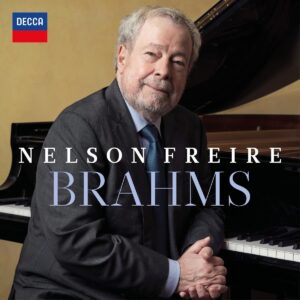At 22, Nelson Freire recorded Brahms’ F minor sonata for his debut recital LP on the CBS label, a superb performance first reissued as part of Philips’ Great Pianists of the 20th Century series, and later in Sony/BMG’s boxed set devoted to Freire’s complete Columbia Masterworks albums. Fifty years later the pianist returns to the scene of the crime, so to speak.
Time has neither slowed Freire’s fingers nor his responsiveness, despite one or two inconsequential split notes. If anything, Freire brings more variety of articulation, tone color, and nervous energy to the table, not to mention restoring the first movement’s exposition repeat. He shapes the first-movement recapitulation’s cross-rhythmic phrases to more flexible and poetic effect this time around. As before, Freire phrases the Andante in two-beats-to-the-bar, as opposed to, say, Claudio Arrau’s more expansive four-beats approach. This time, however, he creates more three-dimensional textural effects by slightly desynchronizing his hands now and then, “old school” style in the manner of great Brahms F minor recordings from the past by Percy Grainger, Harold Bauer, and Etelka Freund.
The Scherzo is less bass-oriented now, with sharper and sometimes quirkier emphasis of the dotted motive’s syncopations. While Freire’s earlier Intermezzo movement was a bit stiff and studio bound, the new version benefits from a faster all-around tempo, with the left-hand “funeral march” motive in appropriately muted perspective. The Finale abounds with zest and forward drive, including the coda, although Freire’s earlier recording of the latter was faster and wilder still.
A judicious selection of late pieces follows the sonata. In contrast to Volodos’ rubato-laden introspection, Freire plays the music-box-like Op. 76 No. 3 Intermezzo at a steady, animated pace, making interpretive points through voicing and touch. In contrast to pianists who focus on Op. 76 No. 4’s songful top line, Freire’s strong left hand presence aptly demonstrates why the music is really “chamber music for solo piano”.
Freire’s full-bodied Op. 116 No. 4 is beautiful in its own way, even if Glenn Gould’s leaner kind of linear transparency is more to my taste. On the other hand, his moderate tempo for the G minor Op. 118 No. 3 Ballade allows the chords that constantly jump between registers to fully resonate. And Freire’s heartfelt yet truly thought-out Op. 119 interpretations rank among the catalogue’s best. The popular A-flat Waltz closes out this captivating, highly recommendable release.
































